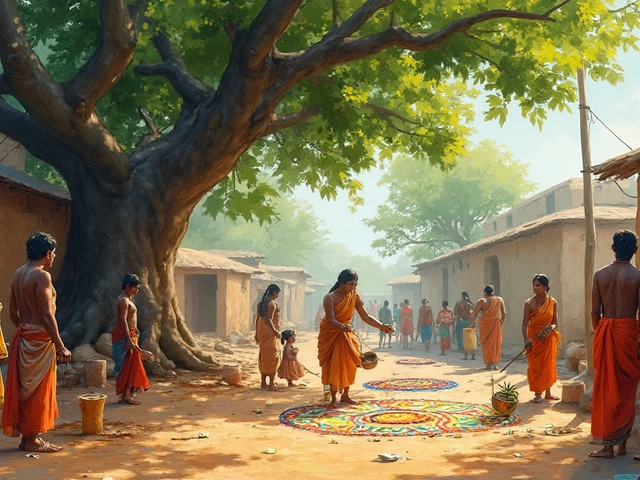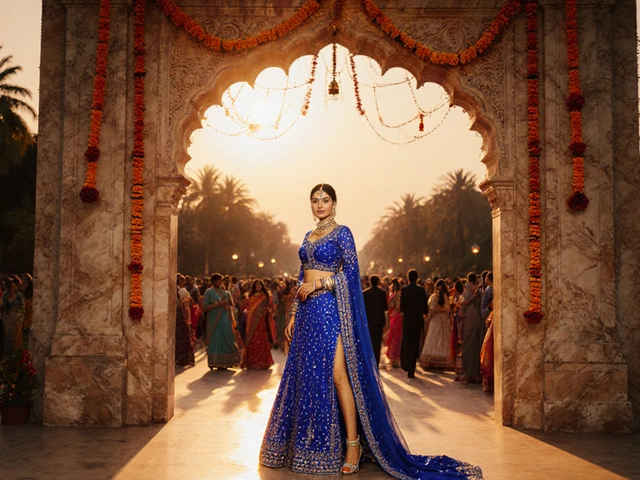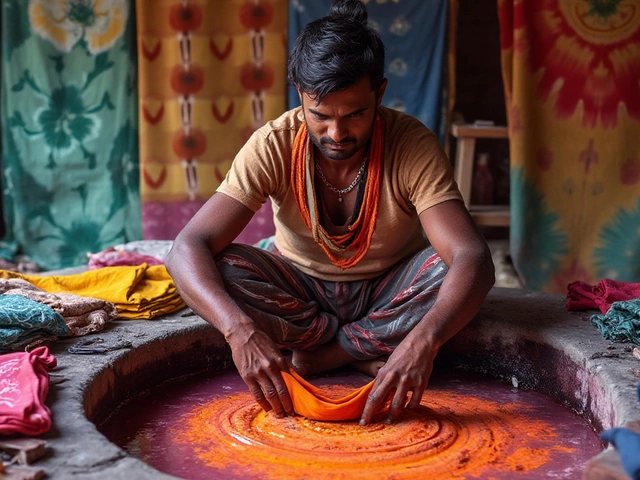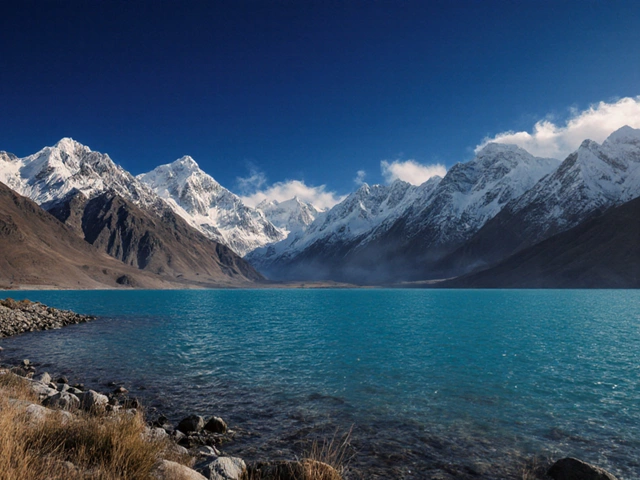Walk into any ancient temple or cave in India and you’ll see something wild—art that goes way beyond just decoration. It’s everywhere, carved into stone walls or painted with pigments that have lasted for centuries. Indian art isn’t just old; it’s on another level when it comes to detail and meaning. Even today, modern artists around the world study these ancient works to pick up new tricks or just to find inspiration nobody else can copy.
What makes Indian art different? It’s not just pretty pictures or fancy statues. Most of these pieces actually tell stories—about gods, regular folks, epic battles, and everyday life. There’s a reason a lot of this stuff shows up in history books and even in Hollywood movies: it packs a punch. You can see the same scenes repeated from tiny village shrines to massive ancient cities, showing how much art meant to the people living then.
Don’t think you need to be an art expert to get this—once you spot the wild dance poses from a 2,000-year-old sculpture or the vibrant murals in a dark cave, you’ll see why it’s so gripping. Ancient Indian art is all about storytelling, technique, and a fearless use of color and form. If you’re curious about how these masterpieces were made or what they mean, you’re in exactly the right place.
- Origins of Indian Art
- The Storytelling in Ancient Sculptures
- Murals and Frescoes: More Than Decoration
- Symbolism and Spirituality in Art
- Techniques That Shaped the World
- Why Ancient Indian Art Still Matters
Origins of Indian Art
If you want to know where it all started, look no further than the Indus Valley Civilization. We're talking about a culture that showed serious talent over 4,000 years ago. Archaeologists found pottery, tiny bronze figures, and detailed seals covered in animal designs and symbols. The city of Mohenjo-daro alone gave us the famous Dancing Girl statue—just 11 cm tall, but full of attitude and style, showing that even back then, art was more than basic decoration.
Ancient Indian art really took off because it wasn't only for the rich or the religious elite. Everyday folks had their hands in creating terracotta toys, utensils, and tiles with animal and plant patterns. From trade with places like Mesopotamia, artists picked up new ideas and techniques, making their work stand out even more.
Religious life also pushed art forward. As early as 300 BCE, Buddhist monks built massive stupas like Sanchi, loaded with carvings of animals, people, and the Buddha's life. Hindu temples and Jain monasteries brought in even more fresh styles, mixing local traditions with influences from Greeks, Persians, and Central Asians—India was always a crossroads for creativity.
Check out this quick breakdown of key periods and what they gave us:
| Period | Major Art Forms | Famous Sites/Artifacts |
|---|---|---|
| Indus Valley (c. 2500–1500 BCE) | Terracotta, seals, bronze | Dancing Girl, Pashupati Seal, pottery |
| Maurya (c. 322–185 BCE) | Stone pillars, sculpture | Ashoka Pillars, Didarganj Yakshi |
| Buddhist Era (after 3rd century BCE) | Stupas, rock-cut caves | Sanchi Stupa, Ajanta Caves |
| Gupta Period (c. 320–550 CE) | Temple sculpture, painting | Udaygiri Caves, Deogarh Temple |
The bottom line? The India art scene didn’t start small or slow—it exploded from the very start, staying fresh and relevant through centuries of change. If you ever get to see these old works in a museum or temple, you're actually looking at the roots of a tradition that's still alive now.
The Storytelling in Ancient Sculptures
Ancient Indian sculptures aren’t just decorations—they’re like stone comic books packed with myths, local legends, and even historical events. Back then, most people couldn’t read or write, so artists let their hands do the talking. Temples and caves became the scene for epic tales, with each carving adding more drama to the story.
A great example is the carvings of the Mahabharata and Ramayana—India’s big epic sagas—right on the walls of the Ellora and Mahabalipuram cave temples. These stone panels show famous battles, gods in action, and classic moments like Rama breaking the bow. You can literally follow a story as you walk along the temple walls. The details are crazy—warriors have different armor, animals look lively, and emotions show up on tiny faces despite the hard rock.
It’s not just about heroes and gods. Some sculptures show street scenes: musicians, dancing girls, people making offerings. There’s even a panel at the Sanchi Stupa that quietly shows a family meal. The stories here aren’t just from books—they show what life was really like, what people wore, what games kids played, and what animals shared their space. If you ever visit, look for the little things—like monkeys hanging out in the background or villagers gossiping in a corner.
In India, art and religion blur together. For many sculptors, it was key to help people understand the big spiritual ideas through real, down-to-earth scenes. That’s why you see gods with many arms or animal heads—it’s all about explaining stuff that’s hard to put into words. And because every region had its own style, you’ll spot major differences between, say, the Chola bronzes down south and the stone figures at Khajuraho in the north.
Why does this matter for ancient art? Because this is where Indian culture really stamped its identity. You can study the statues and spot how society changed—who became important, which stories mattered most, and how people looked at life and death. It turns visiting old temples into a scavenger hunt for clues that are still relevant today.
Murals and Frescoes: More Than Decoration
You might think murals in India were just for brightening up walls, but they did way more. These massive artworks, especially inside caves like Ajanta and Ellora, actually told stories, taught lessons, and sometimes laid out entire myths from start to finish. The Ajanta cave paintings, for example, go back as far as the 2nd century BCE and still wow visitors with their detailed scenes from Buddha's life and ancient Indian society.
What’s wild is how much info these murals pack in. You get to see not just kings and gods but regular people—musicians, traders, families—all caught up in daily life over a thousand years ago. Unlike boring old stone carvings, murals could play with color and add lots more detail. Natural pigments from things like red ochre, indigo, and even cow dung kept the colors bright, sometimes for centuries.
If you're thinking this is just an Ajanta thing, it's not. Kerala, Rajasthan, and Madhya Pradesh each have their own mural styles. In Kerala, temple walls are splashed with bold scenes from Hindu epics. Rajasthan's Shekhawati region turns entire villages into open-air galleries, with houses painted top to bottom—kind of like street art, just hundreds of years old.
Want a quick side-by-side? Here’s a look at famous mural sites and what they’re known for:
| Site | Region | Main Themes | Era |
|---|---|---|---|
| Ajanta Caves | Maharashtra | Buddha’s life, Jataka tales | 2nd BCE–5th CE |
| Ellora Caves | Maharashtra | Hindu, Buddhist, Jain art | 6th–8th CE |
| Shekhawati | Rajasthan | Folk tales, gods, everyday life | 18th–19th CE |
| Mattancherry Palace | Kerala | Ramayana, Hindu deities | 16th CE |
The India mural and fresco tradition isn’t just history—it’s a treasure trove for anyone interested in stories, colors, and the way people saw their world. Artists today still copy technique and themes from these ancient works for a reason: they knew how to keep people looking, reading, and thinking.

Symbolism and Spirituality in Art
Ancient Indian art isn’t just about what you see—it’s packed with hidden meanings. Almost every painting, sculpture, and carving from this period has some spiritual message or symbol tied to Hinduism, Buddhism, or Jainism. If you spot a hand gesture (called a mudra) in a sculpture, it’s not just random. For example, the ‘abhaya mudra’—an open palm—stands for protection and fearlessness. You’ll see gods and goddesses showing this exact pose on temple walls across India.
Colors play a big role too. Red often means power or passion, while blue stands for divinity. Krishna, one of India’s most famous gods, is almost always painted blue. If you see gold in murals or statues, it’s usually not just for decoration; it’s pointing to wealth or spiritual purity.
Ancient artists were obsessed with balance. Statues are rarely placed alone—there’s a system. You’ll see three main figures or symmetrical patterns, which are based on ideas that everything in the universe is connected and balanced. A classic example is the trinity of Brahma (the creator), Vishnu (the preserver), and Shiva (the destroyer), often seen together.
Some symbols show up again and again. Here are a few you’ll notice:
- Lotus Flower: Stands for purity, since it grows from mud but stays clean.
- Conch Shell: Means victory and good news (big in Hindu and Buddhist art).
- Wheel (Chakra): Seen in Buddhist and Hindu art, symbolizes life, change, and the path to enlightenment.
- Animals like elephants and peacocks: Elephants often mean strength or wisdom, while peacocks can suggest beauty and immortality.
The spiritual value of ancient Indian art isn’t just in temples or old ruins; it pops up in daily life, from home shrines to festival decor. Artists believed their hands were guided by higher powers, sometimes making art while chanting or in a meditative state to make the work more powerful.
| Common Symbol | Meaning | Where You’ll Find It |
|---|---|---|
| Lotus | Purity, rebirth | Paintings, sculptures, temple pillars |
| Chakra (Wheel) | Life, cosmic order | Buddhist stupas, coins, temple art |
| Abhaya Mudra | Fearlessness, blessing | Statues of Buddha, Hindu deities |
| Conch Shell | Victory, good omen | Wall reliefs, ritual objects |
If you’re trying to spot these symbols yourself, temples in South India, Ajanta caves, and early Buddhist sites like Sanchi Stupa are a solid place to start. Knowing these signs makes every temple visit or museum trip way more interesting, since you’re not just looking at old stuff—you’re cracking the code of ancient Indian beliefs.
Techniques That Shaped the World
If you think people thousands of years ago only had basic tools, think again. Artists in ancient India came up with some wild techniques that made their art stand out—and honestly, surprise even skilled modern artists. India became a ground for experimenting with materials, tools, and even science (yep, they were mixing up their own paints from minerals and plants long before commercial paint was a thing).
One of the most famous methods is stone carving. Back in the days of the Mauryan Empire, artists would polish sandstone until it shined like glass. You can still see this at the Lion Capital of Ashoka, dating from around 250 BCE—it almost looks machine-made, but it’s totally done by hand. Elora and Ajanta cave carvings prove that with chisels, hammers, and a lot of patience, you could create whole rooms filled with intricate sculptures—not just flat figures, but layers and deep scenes with real depth.
- Fresco painting: At Ajanta, artists used a mix of clay, cow dung, and rice husks as their canvas, then painted while it was damp. This method locked in the colors for centuries, which is why those cave murals are still so bright.
- Metal casting: The lost-wax technique (cire perdue) let artists make bronze statues with incredible detail. The famous Chola bronzes? Made this way nearly a thousand years ago, showing perfectly balanced dancers and lifelike poses.
- Terracotta work: Forget simple pottery. The Indus Valley folks were making realistic animal figurines, wheels, and even little toy carts from soil, fired so it lasted generations.
Just to give you some hard facts, check out how different time periods lined up with their favorite art techniques:
| Period | Main Technique | Famous Example |
|---|---|---|
| Indus Valley (c. 2600–1900 BCE) | Terracotta molding | Dancing Girl statue |
| Mauryan (c. 322–185 BCE) | Polished stone carving | Lion Capital of Ashoka |
| Gupta Era (c. 320–550 CE) | Stone/metal sculpture | Buddha statues, Sarnath |
| Chola Period (c. 850–1250 CE) | Lost-wax bronze casting | Shiva Nataraja |
So next time you see ancient Indian art, think about the tools and brains behind it. They weren’t just making pretty things—they were rewiring how the world thought about materials, color, and form. These techniques didn’t stay in India either. Traders and travelers took these ideas to Southeast Asia and beyond, so a lot of old art you see in places like Cambodia or Indonesia actually has roots in ancient India.
Why Ancient Indian Art Still Matters
It’s honestly wild how often you see ancient Indian art pop up in places you’d never expect—museum shows in London and New York, modern graphic design, even tattoos. This isn’t just nostalgia or fanfare; there’s real substance behind the hype. Ancient Indian art is still taught in design schools and art history classes worldwide, and for good reason. Its storytelling style and mix of practicality with beauty are things today’s artists are still chasing.
Take yoga poses you see plastered on Instagram. A ton of those postures were first shown in stone carvings at temples like those in Khajuraho. How’s that for crossovers? Or look at Bollywood dance moves—they use hand gestures (mudras) found in classic temple art, which literally goes back over a thousand years. This old stuff is influencing pop culture in ways most people don’t even notice.
The real kicker is how ancient Indian art is still shaping our understanding of India itself. Every year, the Ajanta caves alone pull in over 450,000 tourists, and the Indian government invests millions to preserve heritage sites. There’s huge business in this—art festivals, cultural tours, collectibles, and even tattoos. It’s not just about pride; it fuels local economies and keeps traditions alive in real, daily ways.
| Site | Annual Tourists | Preservation Funding (USD) |
|---|---|---|
| Ajanta Caves | 450,000+ | $11 million (2023) |
| Ellora Caves | 600,000+ | $8 million (2023) |
Another point: modern artists and designers often look to ancient Indian art when they want to try something different or make something feel "timeless." Those bold colors, the mix of patterns—they make anything stand out. Even if you’re not into painting or history, just seeing how much old Indian art shows up in everyday stuff (from block-printed fabrics to shop signs) is eye-opening.
The bottom line? Ancient Indian art matters because it’s baked into so much of what you see today. It’s not stuck in a glass case somewhere; it’s in the street, in movies, on bodies, and in the way people celebrate their lives. That kind of staying power makes you realize you’re looking at something more than just pretty pictures—it’s living culture.





